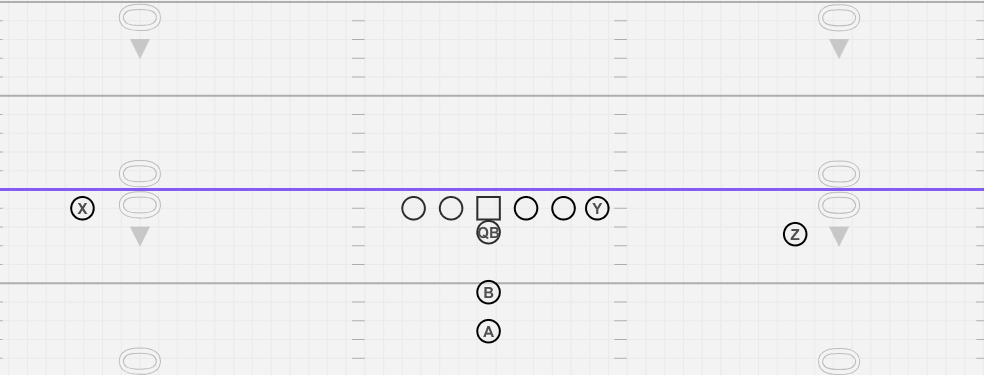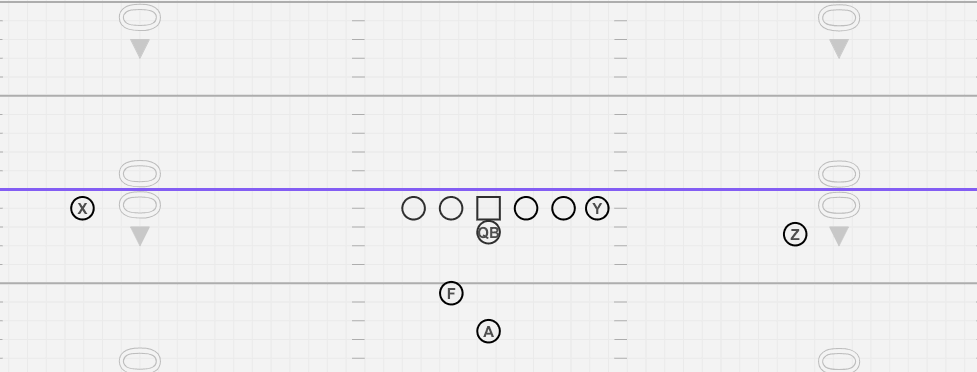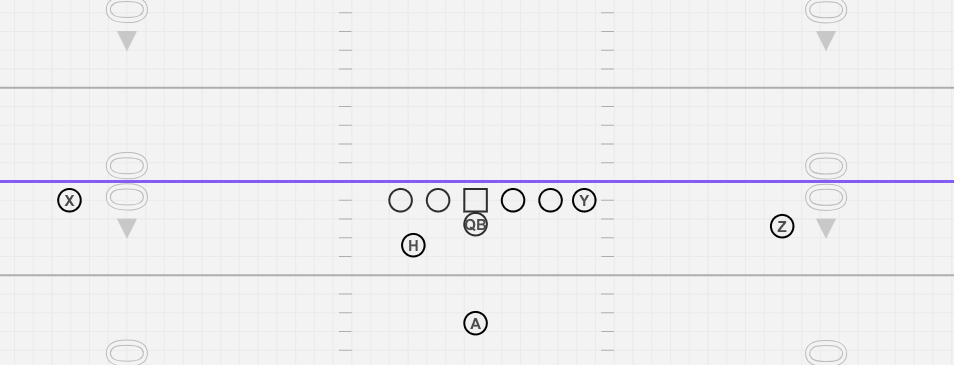Have you ever watched a football game on TV and heard the announcers talking about the X Y Z receivers? These receivers are unique to different offenses in football.
The X Y Z receivers are offensive positions in American football. The Z receiver is a wide receiver that lines up off the line of scrimmage. The X receiver, also known as the split end, lines up on the line of scrimmage. Last, the Y receiver is the tight end that lines up on the line of scrimmage.
These receivers typically play into all types of systems – whether a ground attack, a heavy RPO system like Oklahoma runs, or a pass-heavy offense.
Receivers In Football
As passing schemes became more complex, coaches started to revert from saying “wide receiver, slot receiver, or wideouts.” Coaches had to start labeling receivers that correspond to their position on the field.
If you look into complex offenses (such as Andy Reid’s offense), you’ll see many motions and shifts from the X Y Z receivers. Here’s a prime example:
The offensive coordinator for the Pittsburgh Steelers, Matt Canada, is also famous for his motions and shifts. Offensive coordinators will often create confusion for the defense by motioning and shifting.
Here is an example of Matt Canada’s offensive shifts when he was at LSU:
Teams will tag receivers with letters (X, Y, Z receivers, for example) to call these complex plays in the huddle.
Coordinators can tag their play with simple letter checks and add it to any play based on the type of motion (jet, deep, return, etc.). However, it makes it tougher to call plays with picture boards or hand signals.
A simplistic example would be:
“I-pro Right, Z-jet, 22 dive”
Now that we’ve laid the foundation of the receivers, let’s look at who is often targeted when these letters are named. This was a staple in the West Coast Offense.
If you’re unfamiliar with the West Coast system, learn more about it here!
X Y Z Receivers
Positions were often named by location. For example, it was common to hear “flanker, split end, wide receiver, or tight end.”
However, as offenses got more complex and diverse, coaches started to create systems where they could change routes on the fly (for example, change what the Z receiver is doing just by saying “Z-Slant” or “Z-Out”).
This complexity has made the game harder to understand.
This is why we created the Complete Football Guide to help you better understand the complete football game.
Below is an image of a basic formation we will break down to help identify the X Y Z receivers.

X Receiver
This receiver is typically on the line of scrimmage and flexed out wide. The X receiver is also known as a split end or a “wideout.”
This player is often the offense’s most talented receiver. Common routes this wide receiver will run are fly routes, dig routes, and slant routes.
Coaches will often tag the X route in the West Coast offense to do a custom route. This allows coaches to be flexible with how they call plays and get their best receiver the football.
Z Receiver
The Z receiver, also known as the flanker, lines up off the line of scrimmage.
This player often motions in and out of the formation before the snap. These players often speed players that don’t have to worry about an immediate jam from a defensive player.
The x and z receivers are often lined up the widest but can be flexed out. Players like Wes Welker used to motion in from the Z position to get to the slot receiver position.
Y Receiver
The Y receiver has grown popular over the years (especially in the NFL) as the “tight-end” position. The ability to pass, catch, and block has made an immediate impact on the field. It is also a matchup nightmare for linebackers, as they are forced to run with bigger, faster athletes. An example of a Y receiver in the NFL is Rob Gronkowski or Travis Kelce.
We often see this position lined up next to the offensive tackle or slightly flexed away from the tackle.
The tight end position is best known for playing with their hand on the ground, on the line of scrimmage next to the offensive linemen. If the coach wants to use the tight end off the line of scrimmage, this will often be labeled as the H-back.
Teams will get creative and use these types of wide receivers to match what they are trying to do. Zone schemes often use a Y receiver on the line of scrimmage while gap scheme runs will get the H back into the mix pulling with other offensive linemen.
Learn How To Watch Film Properly…
Uncover your opponent’s offensive and defensive tendencies so you can easily build a game plan.
Inside You’ll Find:
- Strategies to pick apart defenses
- How to identify player weaknesses
- How to save time in your weekly breakdowns
A T B Receivers
A/T/B Receiver – The featured running back. This position is lined up directly behind the quarterback or next to him in a shotgun formation. Often referred to as the “Tail Back, Half Back, Running Back.”
B F And H Receivers
This is where things can get tricky. Depending on the play call (and the coach’s system), the second running back in the backfield’s letter can change. Let’s break it down!
B Receivers – Line up as a true fullback. We often see the B in I-formation or any power formation. The fullback position has become less popular with the innovation of the spread offense.
F Receivers– The F, or the offset fullback, is still responsible for blocking but is a bit more athletic to leak into the flats to catch the football.
H Backs – The H position is becoming increasingly popular as more spread offenses emerge from youth to pro football. The H position can line up anywhere between the tackle or flexed out.
The H-back has become wildly popular over the last eight years. The perfect example is Rob Gronkowski.
Having a player with tremendous size and speed puts defenses in a bind.
Other Wide Receiver Names
Why the H-back, and especially Gronk, is a matchup nightmare is for two reasons:
- Linebackers are too slow to cover him in pass coverage
- Nickel Backs are too small to shed blocks
The tight end is often used in run-blocking sets and the occasional play-action route in a traditional offense.
Players like Gronk, Kelce, and Olsen are big enough to block physically and athletic enough to catch passes in the open.
Defenses are now adjusting by drafting bigger, stronger, and faster outside linebackers that can play all four downs.
This also directly correlates to why people say the “fullback” position is dying.
H-backs give teams the more diverse capability to have a blocking-like position to run plays like power and spread the field in the passing game.
A few fullbacks left in the NFL are guys like Anthony Sherman, James Devlin, and Kyle Juszczyk.
These players are critical pieces in the system that they play in.
As the H-back position becomes increasingly popular, some experts believe the fullback position will eventually die off.
If the game continues to innovate, we may see a new letter position become the new stable in both the run and pass game.
Don’t stop here learning about wide receivers. We’ve created a complete wide receiver university that you can learn from below.
Keep Learning
Once you can identify the X Y Z receivers on the field, you can start to identify how coaches and systems utilize the different receiver positions.
These letters can often change based on the coach’s system.
It’s always good to keep an open mind when learning these systems, as they may change as the game evolves!
Do these letter schemes ( X Y Z receivers) fit with what you learned or are currently coaching? If not, we’d love to hear the different variations of your scheme!




